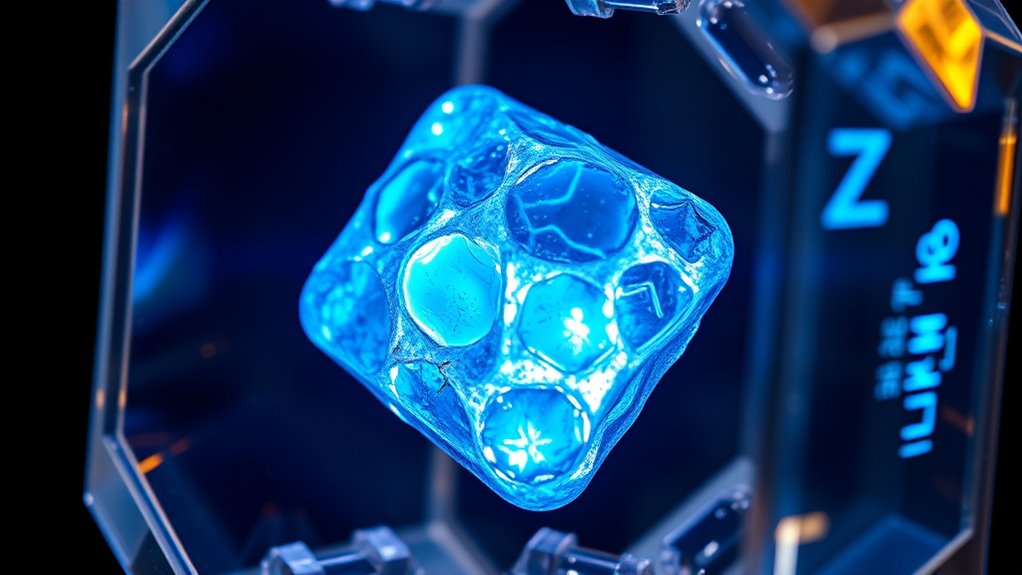With the creation of metallic hydrogen, you can expect breakthroughs in energy storage, superconductivity, and space travel. This exotic material’s high conductivity and stability could revolutionize batteries, enable faster electronic devices, and make spacecraft lighter and more durable. Challenges remain in stabilizing and producing it at scale. If you want to see how this discovery might transform technology and exploration, there’s much more to explore below.
Key Takeaways
- Focus on stabilizing metallic hydrogen under high pressure and temperature control for practical applications.
- Develop scalable manufacturing techniques to produce larger, reliable quantities of metallic hydrogen.
- Explore its potential in energy storage, superconductivity, and advanced space propulsion systems.
- Address safety, regulatory standards, and cost-effective methods for commercial deployment.
- Investigate applications in space exploration, environmentally friendly propulsion, and next-generation electronic devices.
Understanding the Properties of Metallic Hydrogen

Metallic hydrogen is a unique state of matter that exhibits properties unlike those of typical molecular hydrogen. You’ll notice its quantum behavior is extraordinary, with electrons moving freely, similar to metals, rather than being bound to individual molecules. This results from extreme pressure effects—think millions of atmospheres—that force hydrogen into a dense, metallic phase. As pressure increases, hydrogen atoms are pushed so close together that their electron clouds overlap, creating a conducting, metallic state. This changeover isn’t just about density; it radically alters its electrical and optical properties. You might observe metallic hydrogen reflecting light like a metal or conducting electricity with high efficiency. Understanding these pressure effects and quantum phenomena helps explain why metallic hydrogen is so unique among states of matter. Recent experiments have demonstrated the possibility of creating stable metallic hydrogen at high pressures, opening new avenues for research and potential applications.
Implications for Future Energy Storage Solutions

Because of its remarkable electrical conductivity and stability under extreme pressures, metallic hydrogen could revolutionize energy storage technology. Its potential for high energy density makes it an ideal candidate for hydrogen storage, allowing you to store large amounts of energy in a compact space. Unlike traditional storage methods, metallic hydrogen could enable faster charging and discharging cycles, improving efficiency. Its stability at high pressures suggests it might be safely contained and transported, broadening its practical applications. You could see a future where metallic hydrogen replaces current batteries and fuel cells, providing cleaner and more efficient energy solutions. Additionally, advances in Honda Tuning technologies could further optimize energy systems for automotive applications, integrating new materials like metallic hydrogen for better performance. This breakthrough opens doors for advancements in renewable energy storage, helping you reduce reliance on fossil fuels and move toward a sustainable energy future.
Advances in Superconductivity and Electronic Devices

Recent breakthroughs in superconductivity are transforming electronic device technology, making it possible to achieve zero electrical resistance at higher temperatures than ever before. These advances enable faster, more efficient circuits and reduce energy losses. Researchers are exploring how quantum entanglement can enhance device capabilities, allowing for secure communication and quantum computing breakthroughs. The atomic lattice structure plays a pivotal role in developing new superconducting materials, as its arrangement influences electron pairing and resistance properties. By manipulating the atomic lattice, scientists can design materials that superconduct at more practical temperatures. These innovations promise more powerful superconducting magnets, improved sensors, and revolutionary electronic components. As understanding deepens, you’ll see superconductivity becoming integral to next-generation technologies, pushing the boundaries of what electronic devices can achieve. Incorporating Cultural Intelligence into research teams can also accelerate innovation by fostering diverse perspectives and collaborative problem-solving.
Challenges in Stabilizing and Producing Metallic Hydrogen

Stabilizing and producing metallic hydrogen remains one of the most formidable challenges in high-pressure physics. Achieving the extreme pressures (over 400 GPa) requires precise pressure control, which is difficult to maintain consistently. Temperature regulation is equally critical; too much heat causes the hydrogen to revert to a molecular state, while too little hampers the formation process. To overcome these challenges, you need to focus on:
- Fine-tuning pressure application to prevent fluctuations that destabilize metallic hydrogen
- Maintaining ultra-low temperatures to sustain the metallic phase
- Developing advanced containment and measurement techniques to monitor conditions accurately
- Incorporating Crochet styles for locs into experimental setups to explore innovative stabilization methods
Without precise pressure control and temperature regulation, metallic hydrogen production remains unstable, limiting its study and potential applications. These hurdles highlight why creating and stabilizing metallic hydrogen is such a complex scientific task.
Potential Applications in Space Exploration and Propulsion

Metallic hydrogen could revolutionize space exploration by providing enhanced propulsion capabilities that profoundly reduce travel time. Its high energy density promises fuel efficiency advances, making missions more sustainable and cost-effective. Additionally, its strength may lead to stronger, lighter spacecraft structures, improving overall durability and performance. As research progresses, understanding and safely harnessing AI safety measures will be crucial to ensure responsible development of such groundbreaking materials.
Enhanced Propulsion Capabilities
The unique properties of metallic hydrogen could revolutionize space propulsion systems by providing considerably higher energy density than current fuels. This advancement means spacecraft could travel faster and farther with fewer resources. The increased energy density allows for more powerful and efficient propulsion systems, reducing travel times and expanding mission capabilities. With metallic hydrogen, you could see:
- Faster interplanetary journeys, reaching distant planets more quickly.
- Smaller, lighter propulsion engines, saving weight and space.
- Enhanced maneuverability for complex space missions.
- The potential to unlock new propulsion technologies that could further improve space travel efficiency.
These improvements could make deep-space exploration more practical and cost-effective. As metallic hydrogen becomes viable, it will *unseal* new possibilities for spacecraft design and mission planning, transforming how we explore the cosmos. This leap in propulsion technology promises a new era in space travel.
Fuel Efficiency Advances
Advancements in metallic hydrogen not only promise faster and more powerful propulsion but also substantially improve fuel efficiency for space missions. This breakthrough allows spacecraft to travel farther with less fuel, supporting renewable integration of energy sources and reducing emissions. By enabling more efficient engines, metallic hydrogen can minimize the environmental footprint of space exploration. Here’s a quick look at potential benefits:
| Benefit | Impact |
|---|---|
| Increased Fuel Efficiency | Longer missions, less fuel needed |
| Reduced Emissions | Cleaner propulsion systems |
| Enhanced Mission Flexibility | Supports sustainable exploration |
Additionally, understanding the contrast ratio of propulsion systems can help optimize performance and ensure the clarity of mission objectives. With these advances, space travel becomes more eco-friendly, aligning with global efforts to lower emissions while expanding our reach into the cosmos.
Spacecraft Structural Benefits
As metallic hydrogen’s unique properties become better understood, researchers are exploring how it can strengthen spacecraft structures and improve durability in the harsh environment of space. Its incredible strength and lightweight nature could revolutionize spacecraft durability, making vessels more resilient against impacts and radiation. By integrating metallic hydrogen, you could see significant improvements in structural integrity, reducing the risk of failure during long missions. Key benefits include:
- Enhanced load-bearing capacity without adding weight
- Greater resistance to temperature extremes and radiation
- Increased lifespan and safety of spacecraft
- Potential for use in advanced propulsion systems to achieve faster space travel
These advancements could enable deeper space exploration and more ambitious missions, as spacecraft become more robust and reliable. Metallic hydrogen offers a promising path to stronger, lighter structures that withstand the challenges of space travel.
Impact on Fundamental Physics and Material Science

Discovering metallic hydrogen could revolutionize our comprehension of fundamental physics by providing a new state of matter with unique properties. Its extreme density and conductivity challenge existing theories, opening doors to exploring quantum tunneling and particle interactions at unprecedented scales. You might imagine a world where electrons move freely, altering how we understand forces and energy transfer. To visualize its impact:
| Property | Effect on Physics | Material Science Changes |
|---|---|---|
| Quantum tunneling | Faster, more efficient reactions | Superconductors improve |
| Particle interactions | New particle behaviors | Stronger, lighter materials |
| Magnetic properties | Enhanced magnetic effects | Advanced electronic devices |
| Structural stability | More resilient materials | Revolutionary manufacturing |
This breakthrough pushes the boundaries of science, promising innovations in both fundamental physics and material science. Understanding the behavior of electrons in such states could lead to breakthroughs in energy storage and transmission.
Next Steps for Research and Commercialization

To advance metallic hydrogen, you need to focus on scaling up production methods to make it more feasible. You should also evaluate potential commercial applications to determine where it can offer the most value. Addressing both challenges will be key to turning this scientific breakthrough into practical use. Additionally, understanding the resources and tools available can facilitate collaboration and innovation in this emerging field.
Scaling Production Methods
Advancing the production of metallic hydrogen requires developing scalable methods that can move beyond laboratory experiments. Overcoming manufacturing challenges is essential to produce it reliably and in larger quantities. To achieve this, focus on:
- Improving high-pressure technology to maintain extreme conditions at scale.
- Designing robust, repeatable processes that minimize contamination and defects.
- Developing cost-effective equipment capable of consistent, large-volume production.
Addressing these points guarantees you can transition from experimental setups to practical manufacturing. Scaling production involves refining techniques to handle the intense pressures needed while maintaining safety and precision. Overcoming manufacturing challenges will be pivotal to unlock metallic hydrogen’s full potential, paving the way for future applications and commercialization.
Navigating Commercial Applications
What are the critical next steps to transform metallic hydrogen from a laboratory curiosity into a viable commercial product? First, you need to focus on increasing market adoption by demonstrating its practical benefits, such as energy efficiency or material strength. Developing scalable production techniques is essential for meeting demand and reducing costs. Simultaneously, you must address regulatory considerations, ensuring compliance with safety standards and obtaining necessary approvals. Establishing clear guidelines will help build trust with industry stakeholders and consumers. Collaborate with government agencies and industry partners to navigate legal frameworks smoothly. As you advance, prioritize thorough testing and validation to prove metallic hydrogen’s reliability. These steps will pave the way for transitioning from experimental success to real-world applications, unlocking its full commercial potential.
Frequently Asked Questions
How Long Can Metallic Hydrogen Be Maintained Under Laboratory Conditions?
You might wonder how long metallic hydrogen can stay stable in laboratory conditions. Currently, its storage stability is limited because maintaining the extreme pressures required is challenging. Experimental duration often spans only a few moments before the material reverts or degrades. Researchers are working to improve containment techniques to extend this period, aiming for longer-term stability that could release future scientific and technological breakthroughs.
What Are the Environmental Risks Associated With Metallic Hydrogen Production?
When considering the environmental impact of metallic hydrogen production, you should focus on potential ecological safety concerns. The process might involve high pressures and temperatures, which could pose risks of unintended reactions or toxic byproducts. You need to evaluate whether the methods used could harm ecosystems or release harmful substances. Ensuring ecological safety is essential to prevent long-term environmental damage and maintain responsible handling of such advanced materials.
Could Metallic Hydrogen Replace Traditional Fuels in the Near Future?
You might wonder if metallic hydrogen could replace traditional fuels soon. While it holds promise as an alternative energy source, practical use is still years away due to production and stability challenges. Its future implications include potentially revolutionizing energy storage and transportation. However, you should stay informed about ongoing research, as breakthroughs could accelerate its viability, shaping a cleaner, more efficient energy landscape for generations to come.
What Safety Precautions Are Necessary When Handling Metallic Hydrogen?
Handling protocols for metallic hydrogen are crucial to guarantee safety and prevent accidents. You should always wear proper protective gear, work in controlled environments, and follow strict guidelines. Emergency preparedness is equally important; know how to respond swiftly if a leak or unexpected reaction occurs. By adhering to these precautions, you help keep everyone safe while exploring this exciting, cutting-edge material, making science both thrilling and secure.
How Cost-Effective Is the Current Process of Creating Metallic Hydrogen?
You might wonder about the cost efficiency and production scalability of creating metallic hydrogen. Currently, the process is quite expensive due to advanced equipment and extreme conditions needed. Scaling up production could reduce costs over time, but challenges remain. As you explore potential applications, keep in mind that improving cost efficiency and scalability will be key to making metallic hydrogen more practical and accessible in the future.
Conclusion
Now that metallic hydrogen has finally been created, you’re on the brink of a scientific revolution. It’s like opening a door to endless possibilities—powerful energy storage, super-efficient electronics, and advanced space travel. While challenges remain in stabilizing and producing it at scale, your curiosity and innovation drive the next breakthroughs. Keep pushing boundaries, and you’ll help turn this extraordinary discovery into a transformative reality for the future.










